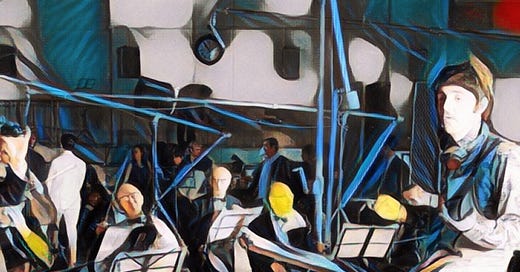There's a peculiar magic that happens when classical strings meet rock and roll. It's like watching oil and water suddenly decide they're best mates after all. The Beatles, those clever lads from Liverpool, didn't just understand this alchemy – they mastered it. With a little help from George Martin and some of London's finest session musicians, they transformed simple pop songs into orchestral masterpieces that still leave listeners spellbound decades later.
Let's count down the ten most magnificent string arrangements that elevated The Beatles' music from brilliant to absolutely transcendent.
10. "Good Night"
What begins as a lullaby transforms into something far more profound through the sweeping orchestral arrangement. The strings here don't just accompany – they embrace, they comfort, they transform Ringo's tender vocal into something approaching a cosmic bedtime story. It's tremendously affecting stuff, proving that sometimes the most straightforward approach can yield the most powerful results.
9. "Glass Onion"
Here's where things get deliciously cheeky. The string arrangement slices through the song like a razor blade, creating an almost cinematic tension. It's deliberately unsettling, playing against the song's satirical lyrics with an intensity that suggests something far more sinister lurking beneath the surface. This is The Beatles at their most knowingly theatrical.
8. "The Long and Winding Road"
Now, this one's controversial, darlings. The Phil Spector production has been debated endlessly, but strip away the opinions and listen to those strings in isolation – they're absolutely magnificent. They surge and retreat like waves, creating a sense of journey that perfectly matches the song's central metaphor. Yes, perhaps they're overwhelming at times, but isn't that rather the point?
7. "Something"
George Harrison's masterpiece gets the string arrangement it deserves. George Martin's work here is subtle but crucial – the strings don't announce themselves with fanfare but rather seep into your consciousness gradually. By the time they reach full flight in the bridge, they've become as essential to the song as Harrison's guitar solo. It's an arrangement that enhances rather than overwhelms.
6. "She's Leaving Home"
The string arrangement here isn't just accompanying the story – it's telling it. Each phrase mirrors the emotional weight of the lyrics, from the gentle awakening of the opening to the heart-wrenching climax. It's like watching a mini-film play out through sound alone. The interplay between harp and strings creates a particularly poignant effect, suggesting both the freedom of flight and the weight of consequences.
5. "I Am the Walrus"
Absolute genius, this one. The string arrangement is practically anarchic – slashing, swooping, diving like a flock of demented seabirds. It's the perfect complement to the song's surrealist lyrics, creating a carnival atmosphere that somehow makes the nonsensical make perfect sense. The way the strings interact with the Mike Sammes Singers is particularly inspired, creating a sort of controlled chaos that still sounds revolutionary today.
4. "Strawberry Fields Forever"
The strings here don't just arrange – they paint. They create a psychedelic landscape that's both beautiful and slightly menacing. Listen to how they slide between notes, how they create that dreamlike quality that makes the track so distinctive. It's not just an arrangement; it's a crucial part of the song's DNA, as important as Lennon's double-tracked vocals or Ringo's hypnotic drumming.
3. "A Day in the Life"
The famous orchestral glissandos might be the most talked-about aspect of this arrangement, but it's the subtle string work throughout that really makes the song so spectacular. The way the strings build tension, release it, then build it again creates a sense of mounting drama that makes the song's climactic moments all the more powerful. It's like watching a thriller unfold in musical form.
2. "Eleanor Rigby"
This is where The Beatles rewrote the rulebook. The double string quartet arrangement is stark, modern, almost aggressive – more Bernard Herrmann than Percy Faith. It's chamber music for the pop age, creating a sonic landscape that's both beautiful and unsettling. The way the strings drive the rhythm, becoming both the song's backbone and its emotional core, was revolutionary for its time and remains startling today.
1. "Yesterday"
Sometimes the simplest things are the most profound. The string quartet arrangement here is absolute perfection – understated yet emotional, complex yet seemingly effortless. It's like a masterclass in how to arrange strings for a pop song. Each note serves a purpose; each phrase enhances rather than decorates. It's the arrangement that launched a thousand imitators, yet none have quite captured its magic.
The Final Note
What becomes clear when examining these arrangements is how The Beatles, along with George Martin, understood that strings weren't just fancy decoration – they were another voice in the band, capable of expressing emotions that even the finest lyrics couldn't capture. These arrangements didn't just add classical respectability to pop music; they helped create a new musical language altogether.
The legacy of these arrangements can be heard everywhere today, from the most intimate indie recordings to the grandest pop productions. They showed that when it comes to emotional expression in popular music, there's no limit to what can be achieved when imagination meets expertise. The Beatles didn't just use strings – they reimagined what strings could do in popular music, and we're all the richer for it.




